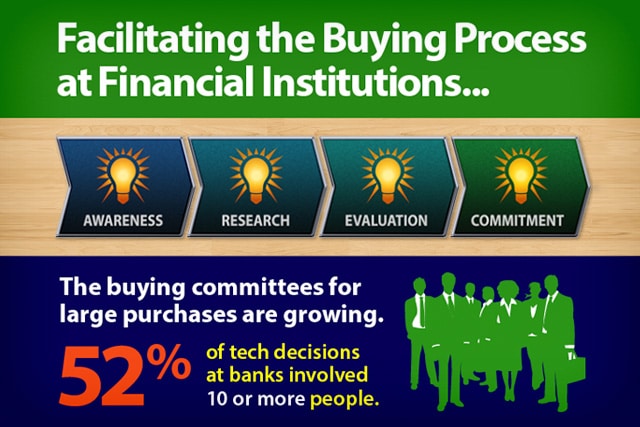![]()

Buying committees for large purchases at financial services firms are growing. Recent research by CCGroupPR found that 52% of technology decisions at banks involved 10 or more people. Whenever a big tech investment is being considered, stakeholders from various functional and regional divisions have to reach consensus on a strategy in order to move a transaction forward.
Approval Process Getting Tougher
In addition to the growing size of the buyer committee, approval process are also getting more complex. It used to be that MD and EVP-level executives often had budget authority for several million dollars. But recently, several of our clients report that in many large and medium-sized financial institutions, purchases larger than USD $1M now require approval from the C-Suite and sometimes even the board. That makes the selling process much more challenging.
No Decision is More Likely
It’s incumbent on sellers to help buying committees reach consensus. But this is easier said than done. Recent research by Corporate Executive Board (CEB) found that buying committees larger than 5 people have a 69% likelihood of failing to agree on any purchase.
What makes a deal fall apart? Lots of things – few having anything to do with the seller or the competition. Here’s a brief list:
- Competing goals
- Misunderstandings
- Different world views
- Fear of uncertainty
- Political risk
- Interpersonal or intra-group conflict or competition
- Organizational inertia
- Power struggles
- Unwillingness to compromise
That means that for deals to get done at all, someone internal must be very good at selling the rest of the team on his or her vision – helping them capture either the same vision or a vision of their own solution that uses the same ingredients. The best sales people help buyers reach consensus.
Marketing needs to start playing a role in this process.
The best marketing strategists view content marketing not only as a lead generation tool, but as a tool that helps facilitate every stage in the buying process. That means helping to arm internal advocates so they can build consensus in their organizations.
The Buying Process Isn’t a Straight Line
When selling to big committees, you can’t assume that every person on the committee is at the same buying stage simultaneously. Some will binge on your content, speeding through the stages and quickly arriving at a decision that your offering is the best option for their firm. But at the same time, other important committee members might be at the very beginning, slowly becoming aware of the problems. Often, the speedy constituents will need to educate the slower folks to help them get on board.
How Marketing Helps Build Consensus
Awareness Stage
At this stage, buyers start to identify business goals and determine what obstacles must be overcome to achieve them. They need to understand the issues from multiple points of view. They also seek to uncover high-level budget implications and the potential ROI associated with solving the problem.
To help move them forward, provide persona-specific content designed to help them understand their problems and the business impact. Give them some perspective on how their problems are related to issues in other parts of the organization. You should also provide insights on how other firms are solving the problems and the potential returns. This might be in the form of case studies – but only if they’re written as journalism without any kind of promotional focus. Focus on the issues faced by the buyer persona, but also give perspective into the broader organizational impacts.
Ideally, you should have content like this targeting several personas. For example, you might offer one angle for trading that talks about a trading issue and how technology influences the problem. For the trading technology team, you might turn this on its head and talk about the technology problem and how it influences trading. Alternatively, you might talk about an electronic trading issue from a European perspective, also providing a little color into how things are different in Asia. Then for the Asian persona, turn the argument the other direction.
The goal is to give each persona a little perspective into the lives and challenges of their colleagues – people they might not work with directly on a daily basis.
Research Stage
Once they become convinced that the problem needs attention, buyers shift their focus to unraveling the issues and identifying options that will help them reach their goal. Competing interests start to emerge as they analyze root causes and begin to prepare a shortlist of options. This will be particularly evident if the issues affect both electronic and voice trading or if the solution to an EU or North American problem risks causing more challenges for Asia.
Marketing should focus on arming advocates by helping each stakeholder understand needs and evaluate options based not only on their point-of-view but also from the viewpoints of other key stakeholders. The buyers are going to start building a shortlist of options to evaluate, and marketers must be sensitive that their product is never the full solution. No matter how complete your product – a solution still requires investment in tangential products, integration, hardware, staff and workflow changes, implementation, etc. The vendors who are most helpful in offering real insight at this stage often build trust that carries them through challenging evaluations.
Evaluation Stage
Once a short list is developed, buyers evaluate the technical, business and financial feasibility of the shortlisted options. Competing interests and fear dramatically increase as they seek to understand the impact of the various options on the organization. Here, you can expect some parts of the committee to de-rail the decision process for a multitude of reasons. For some, the status quo is working just fine. For others, the solution is a very real threat to their jobs. For others, the approach will negatively affect their ability to run their divisions profitably. And some just fear any kind of change.
Marketing and Sales should be working together to help your internal advocates find common ground and build consensus. Arm advocates with slide decks and other persuasive materials they can use to educate the organization. Help them understand and address the legitimate concerns that other committee members are likely to have, and give them tools to help overcome fear. Often the very tools you give your sales people can be re-worked for use by the customers to help them sell internally and convince other stakeholders.
Commitment Stage
For buyers, this stage is where the “rubber meets the road.” They have to clearly understand and manage all kinds of risks – from implementation mistakes to organizational impacts to regulatory changes. They also need to identify the necessary business and workflow changes, prepare the organization for change, and develop comprehensive implementation plans.
Fear and uncertainty are key reasons that deals are lost at this stage. Rarely do deals fall apart because the buyer doesn’t see business value. CEB’s research found that as buying committees get larger, fear of losing respect doubles and fear of losing a job triples. Sometimes, buying teams are crippled by indecision. CEB’s research found that up to 60% of deals are lost due to no decision.
Here, you should help prospects navigate the commitment process by directly addressing their fears and helping them plan for change. For example, provide them with sample implementation plans that they can use as a starting place. Clearly and honestly communicate the risks and show them how to manage and mitigate each risk.
The more you can build trust in each member of the buying committee, the more comfortable they will feel moving forward. But in many cases, you have to build that trust by empowering your advocates, because sales RARELY gets access to the buyers when they’re feeling fearful.
The Goal is Building TRUST
Content marketing isn’t just about lead generation. It’s about building trust at every step in the customers’ journey. The right content marketing strategy will provide signposts that help your customers to buy while building their confidence in your organization and brand.
The deeper your understanding of your target customer’s purchase process – the more you’ll be able to enhance their experience and increase the close rate on deals already in the pipeline. Your marketing strategy can help facilitate every stage in the customer’s buying process, enabling marketing to make a direct contribution to revenue.
_______________________________________________________________________
PropelGrowth helps financial services firms increase sales by using content marketing to facilitate the customer buying process. To find out more about our services, click here.
If you would like to do more research on this topic, here are some resources:
Blog: How Financial Institutions Buy Technology
Blog: Content Marketing to Build Advocacy in Financial Services
White Paper: How to Feed the Content Beast without Blowing Your Budget
- 4 Steps to Optimize Your LinkedIn Profile for Sales Prospecting – February 12, 2021
- The Reality of Cold Calling for B2B Sales – January 11, 2021
- Can Inbound Marketing Generate Enough Leads? – January 9, 2021







10 responses to “Facilitating the Buying Process at Financial Institutions”
[…] on tactical plans rather than on a customer-centric messaging strategy. Almost none consider the buying cycle and information needed at each stage. These superficial strategies are unlikely to deliver the kind of performance that a more in-depth, […]
[…] agency should also have enough sales focus to know how to align content with the buying cycle in order to get the best results from a content marketing […]
[…] Facilitating the Buying Process at Financial Institutions How Financial Institutions Buy Technology FinTech Marketing – No Field Of Dreams What’s the Difference Between Thought Leadership and Content Marketing? Facilitating The Buying Cycle With Content Marketing Content Marketing for Objection Handling Content Strategy: Stop Feeding Your Audience Dog Juice White Papers Content And Thought Leadership To Support The Buying Cycle […]
[…] they’re not realizing is that buying committees at financial organizations are growing, so there are more people than ever to influence. In fact, recent research by CCGroupPR found that […]
[…] Facilitating the Buying Process at Financial Institutions Content Marketing to Build Advocacy in Financial Services […]
[…] Last year, CCGroupPR’s research study found that financial institution buying committees for large technology purchases are growing. Up to 52% of tech decisions at banks can involve 10 or more people. […]
[…] Buyer Persona Template Facilitating the Buying Process at Financial Institutions […]
[…] Does Your Content Marketing Comply With A Code Of Ethics? Content Marketing to Build Advocacy in Financial Services Facilitating the Buying Process at Financial Institutions […]
[…] For Nurturing Mid- And Late-Stage Leads B2B Buyer Personas – No Shortcuts Facilitating the Buying Process at Financial Institutions The 4 Stages of the Financial Technology Buying Process B2B Lead Conversion – Qualification […]
[…] Facilitating the Buying Process at Financial Institutions How Financial Institutions Buy Technology Content Marketing to Build Advocacy in Financial Services […]